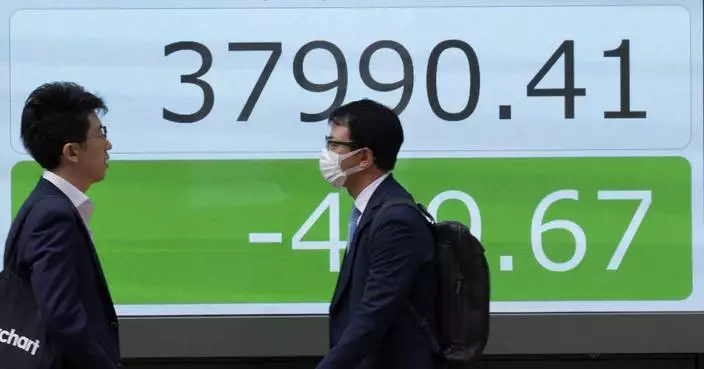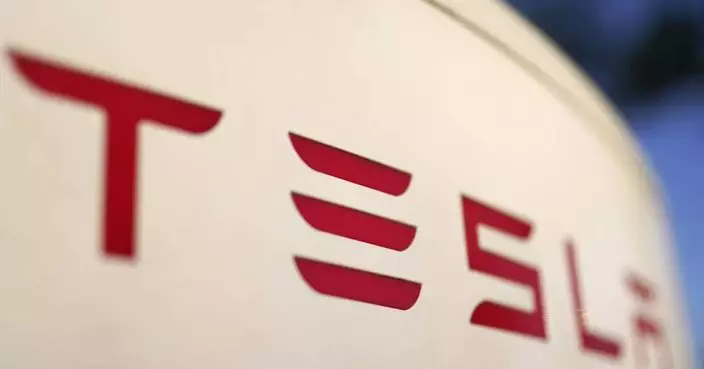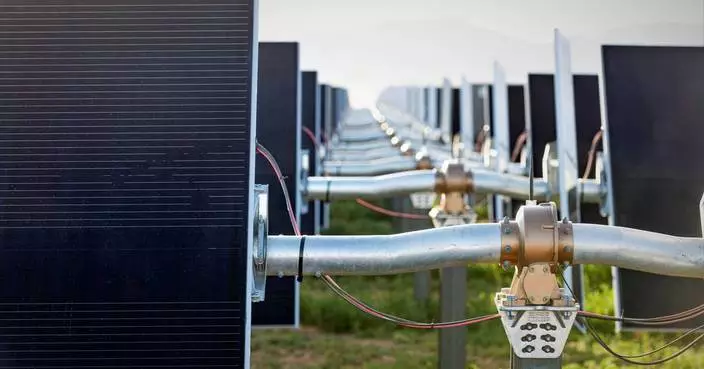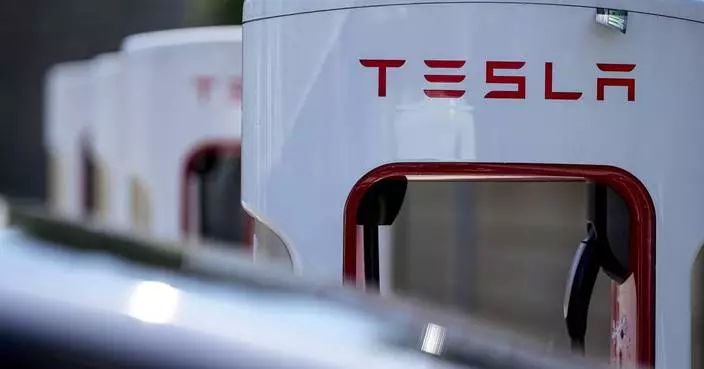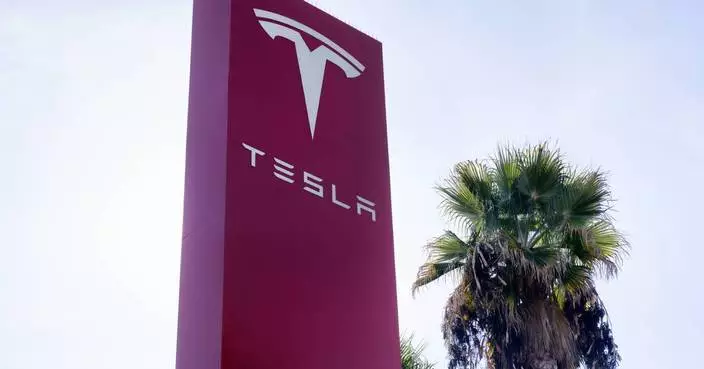The Model 3 is Tesla's most affordable electric car, with a promised starting price of $35,000. Hundreds of thousands of Americans have put down a $1,000 deposit for one. Almost all of them are still waiting for the chance to order.
At Edmunds, however, we've purchased and taken delivery of one of the first Model 3s out. And we've driven it more than 3,000 miles so far.

This undated photo provided by Tesla shows the Tesla Model 3, which delivers a sporty ride with a premium feel. The Model 3 is dramatically quicker and more engaging to drive than other popular EVs such as the BMW i3 and the Chevrolet Bolt. (Courtesy of Tesla via AP)
It's not our first Tesla; we've previously bought and conducted 18-month tests of the Model S sedan and the Model X SUV. We've sampled most other electric vehicles on the market, too. Here's what we can say so far about living with our Tesla Model 3 sedan:
SERVICE AND QUALITY: A WORK IN PROCESS
We're going to get this out of the way first: Tesla's scramble to increase its Model 3 production seems to have adversely affected Model 3 build quality, at least on the basis of our tiny sample of one. Body panel gaps are inconsistent, reflecting a lack of attention to detail, and this applies not only to our own car but even to Model 3s we've seen on display.
After we brought ours home, we discovered it also had a cracked vanity mirror and a broken driver's seat shell. In our first six weeks, we've had to do the equivalent of a Windows PC's Ctrl-Alt-Del reboot of the all-important touchscreen about a dozen times.
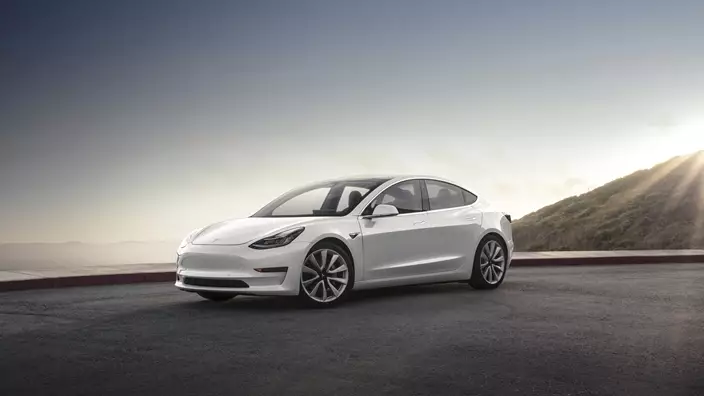
This undated photo provided by Tesla shows the Tesla Model 3, which the automaker has touted as its most affordable electric vehicle. Tesla is only building rear-wheel-drive Model 3 sedans with the expensive 310-mile long-range battery at the moment. The $35,000 version with the smaller battery is still months away. (Courtesy of Tesla via AP)
We've called a Tesla service center about the problems but have had difficulty getting an appointment. Drive-ups were not welcome, so our parts were ordered based on photographs alone. Weeks later, we're still waiting for word and it's hard to get answers.
YOU BETTER LIKE TOUCHSCREENS
The Model 3's minimalist interior is dominated by its huge central touchscreen. There are no gauges, no knobs and no switches except for door-mounted window controls. It looks clean and futuristic, but ease of use isn't as stellar.
Certain controls are accessed from a couple of multi-axis roller buttons on the steering wheel. For just about everything else, you'll be reaching for the touchscreen to access wiper controls, adjust cruise control speed, and even to switch between modes on the audio system. You get used to it, but this approach increases the chances of driver distraction.
The Model 3 doesn't play well with smartphones either. It lacks Apple CarPlay and Android Auto, two systems that easily integrate many of your phone's apps with the vehicle. And its USB ports cannot deliver any music, audiobook or podcast files from your phone to the audio system. The only way to listen to your media files is to stream them using Bluetooth audio.
DRIVES GREAT, RANGE IS APPEALING
Those issues aside, we enjoy driving the Model 3. It feels sorted and sporty when you're driving around turns, and the electric motor delivers plenty of thrust. It's dramatically quicker and more engaging to drive than other popular EVs such as the BMW i3 and the Chevrolet Bolt. That premium feel experienced in the Model S and the Model X is also present.
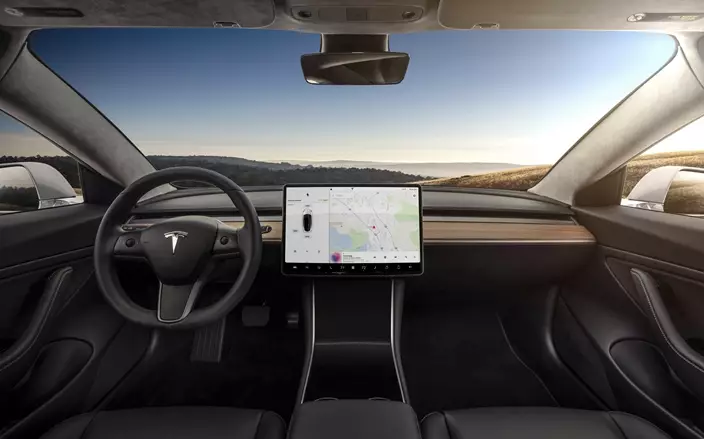
This undated image provided by Tesla shows the Tesla Model 3's minimalist interior with its 15-inch touchscreen as a focal point. The touchscreen looks great, but the driver faces increased risk of distraction because most functions, including the windshield wipers and cruise control speed, are operated from it. (Courtesy of Tesla via AP)
Currently, Tesla is only building rear-wheel-drive Model 3 sedans with the expensive 310-mile long-range battery. The smaller battery and its purported 220-mile range and $35,000 price are still some months away. Edmunds paid $56,000 for its fully loaded Model 3.
At first, we were ready to conclude it's not worth paying more for the big battery. In a regular gasoline car, 300 miles feels like a minimum because no one likes to stop for gas often. By contrast, you can charge an electric car at home every night, and at that point 220 miles is more than enough for daily use.
But there are reasons to go big. Of course, it's an advantage for those who drive farther than average or can't charge every day. But it also has to do with charging speed at Tesla's network of Superchargers. If you've got a Model 3 with the bigger battery, you won't need to spend as much time hooked up to a Supercharger station. Because charge rates slow down as batteries get closer to full, it actually takes less time to bring a 310-mile battery up to 200 miles of range — which is likely all you'll need to get to the next station — than doing the same with the smaller 220-mile battery. The difference could amount to 15 minutes or more per stop, which could really add up during an extended road trip.
EDMUNDS SAYS: Tesla does things differently, which is both a strength and a weakness. The new Model 3 sets a new standard for what an affordable electric vehicle can be. But initial problems highlight Tesla's inexperience with mass-market production.
DETROIT (AP) — The U.S. government's auto safety agency is investigating whether last year's recall of Tesla's Autopilot driving system did enough to make sure drivers pay attention to the road.
The National Highway Traffic Safety Administration says in documents posted on its website Friday that Tesla has reported 20 more crashes involving Autopilot and since the recall. The crashes and agency tests raised concerns about the effectiveness of the remedy. The recall involved more than 2 million vehicles, nearly all the vehicles that Tesla had sold at the time.
The agency pushed the company to do the recall after a two-year investigation into Autopilot's driver monitoring system, which measures torque on the steering wheel from a driver's hands. In the probe, the agency was looking at multiple cases in which Teslas on Autopilot ran into emergency vehicles parked on freeways.
The recall fix involves an online software update to increase warnings to drivers. But the agency said in documents that it has found evidence of crashes after the fix, and that Tesla tried to address problems with additional software updates after the recall fix was sent out. The updates may not have worked.
“This investigation will consider why these updates were not part of the recall or otherwise determined to remedy a defect that poses an unreasonable safety risk,” the agency wrote.
A message was left early Friday seeking comment from Tesla.
NHTSA said that Tesla reported the 20 crashes in vehicles that had received the recall software fix. The agency has required Tesla and other automakers to report crashes involving partially and fully automated driving systems.
NHTSA said it will evaluate the recall, including the “prominence and scope” of Autopilot’s controls to address misuse, confusion and use in areas that the system is not designed to handle.
It also said that Tesla has stated that owners can decide whether they want to opt in to parts of the recall remedy, and that it allows drivers to reverse parts of it.
Safety advocates have long expressed concern that Autopilot, which can keep a vehicle in its lane and a distance from objects in front of it, was not designed to operate on roads other than limited access highways.
The investigation comes just one week after a Tesla that may have been operating on Autopilot hit and killed a motorcyclist near Seattle, raising questions about whether a recent recall went far enough to ensure Tesla drivers using Autopilot pay attention to the road.
After the April 19 crash in a suburban area about 15 miles (24 kilometers) northeast of the city, the driver of a 2022 Tesla Model S told a Washington State Patrol trooper that he was using Autopilot and looked at his cellphone while the Tesla was moving.
“The next thing he knew there was a bang and the vehicle lurched forward as it accelerated and collided with the motorcycle in front of him,” the trooper wrote in a probable-cause document.
The 56-year-old driver was arrested for investigation of vehicular homicide “based on the admitted inattention to driving, while on Autopilot mode, and the distraction of the cell phone while moving forward, putting trust in the machine to drive for him,” the affidavit said.
The motorcyclist, Jeffrey Nissen, 28, of Stanwood, Washington, was pronounced dead at the scene, authorities reported.
Authorities said they have not yet independently verified whether Autopilot was in use at the time of the crash.
On Thursday, NHTSA ended its investigation of Autopilot, citing the recall and the investigation of its effectiveness. The agency said it found evidence “that Tesla's weak driver engagement system was not appropriate for Autopilot's permissive operating capabilities.”
Tesla, the leading manufacturer of EVs, reluctantly agreed to the recall last year after NHTSA found that the driver monitoring system was defective.
The system sends alerts to drivers if it fails to detect torque from hands on the steering wheel, a system that experts describe as ineffective. Although many newer Teslas have cameras that can watch the driver, they can't see at night, and independent testing shows that Autopilot can still be used even if the cameras are covered.
The Associated Press reported shortly after the recall that experts said the fix relied on technology that may not work.
Research conducted by NHTSA, the National Transportation Safety Board and other investigators show that merely measuring torque on the steering wheel doesn’t ensure that drivers are paying sufficient attention. Experts say night-vision cameras are needed to watch drivers’ eyes to ensure they’re looking at the road.
Michael Brooks, executive director of the nonprofit Center for Auto Safety, said NHTSA is looking into where Tesla allows Autopilot to be used.
The company doesn’t limit its use, even though it was designed to operate on limited access freeways. Tesla, he said, appears to rely on computers to decide whether Autopilot can operate rather than maps that show a vehicle’s location.
“When you hit that point where you're in the area where Autopilot wasn't designed to operate and the car knows it's in that area, why is it still allowed to engage?” he asked.
Brooks said NHTSA could seek civil fines and additional fixes from Tesla.
Government documents filed by Tesla in the December recall say the online software change will increase warnings and alerts to drivers to keep their hands on the steering wheel.
NHTSA began its Autopilot crash investigation in 2021, after receiving 11 reports that Teslas that were using Autopilot struck parked emergency vehicles. In documents explaining why the investigation was ended, NHTSA said it ultimately found 467 crashes involving Autopilot resulting in 54 injuries and 14 deaths.
Tesla offers two partially automated systems, Autopilot and a more sophisticated “Full Self Driving,” but the company says neither can drive themselves despite their names.
In investigative documents, NHTSA said it found 75 crashes and one death involving “Full Self Driving.” It's not clear whether the system was at fault.
CEO Elon Musk for several years has said “Full Self Driving” will allow a fleet of robotaxis to generate income for the company and owners, making use of the electric vehicles when they would have been parked. Musk has been touting self-driving vehicles as a growth catalyst for Tesla since “Full Self Driving” hardware went on sale late in 2015. The system is being tested on public roads by thousands of owners.
In 2019, Musk promised a fleet of autonomous robotaxis by 2020 that would make Teslas appreciate in value. Instead, they’ve declined with price cuts, as the autonomous robotaxis have been delayed year after year while being tested by owners as the company gathers road data for its computers.
Tesla says neither system can drive itself and that drivers have to be ready to take control at all times.
Neither Musk nor other Tesla executives on Tuesday’s earnings conference call would specify when they expect Tesla vehicles to drive themselves as well as humans do. Instead, Musk touted the latest version of “Full Self Driving” and said that “it’s only a matter of time before we exceed the reliability of humans, and not much time at that.”
Musk went on to insist that “if somebody doesn’t believe that Tesla is going to solve autonomy, I think they should not be an investor in the company.”
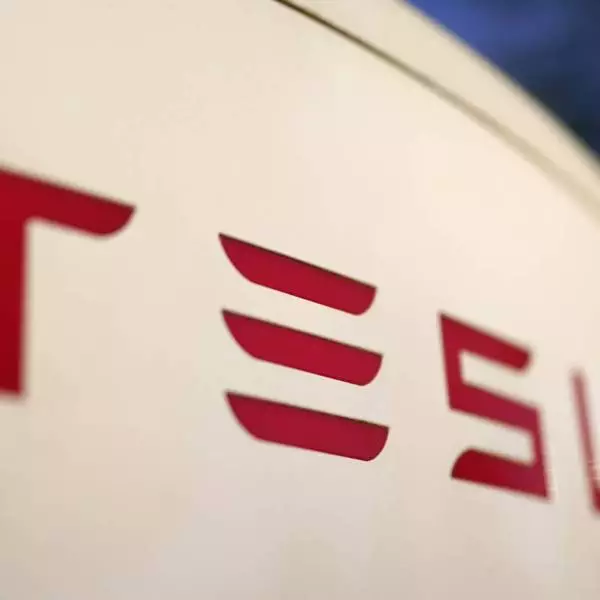
US probes whether recall of Tesla Autopilot driving system did enough to make sure drivers attention
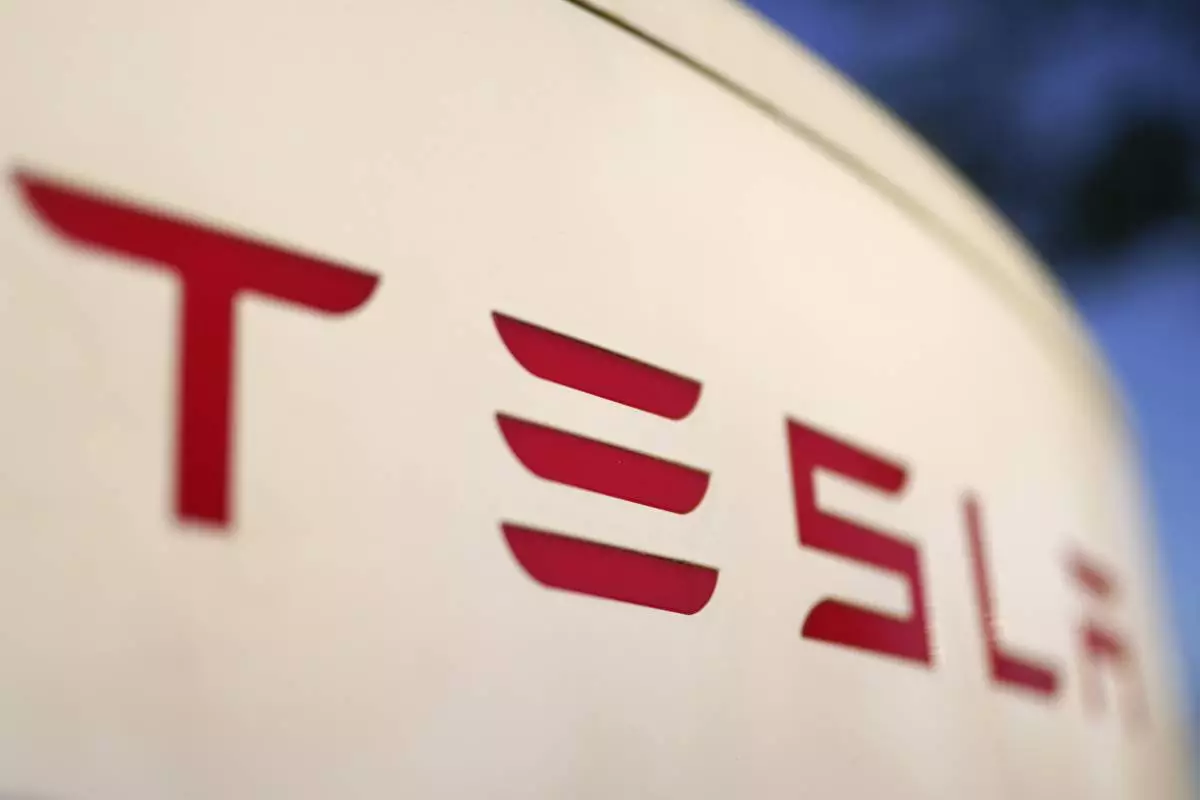
FILE - The logo for the Tesla Supercharger station is seen in Buford, Ga, April 22, 2021. Faced with falling global sales and a tumbling stock price, Tesla has slashed prices again on some of its electric vehicles and its “Full Self Driving” system. Tesla releases first-quarter earnings Tuesday, April 23, 2024. (AP Photo/Chris Carlson, File)
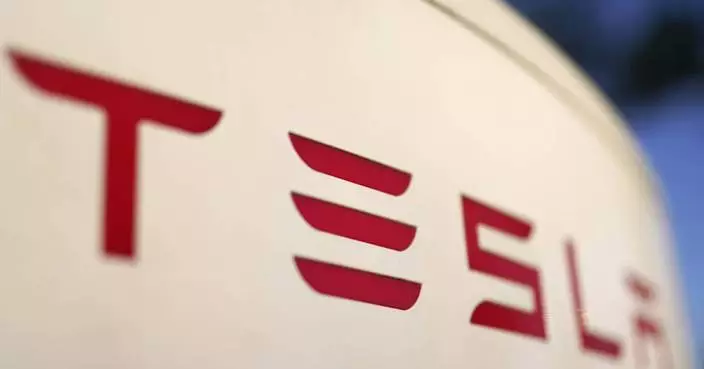
US probes whether recall of Tesla Autopilot driving system did enough to make sure drivers attention









